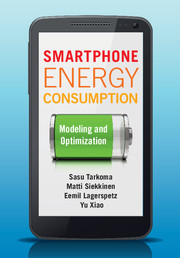Book contents
- Frontmatter
- Contents
- Preface
- List of abbreviations
- Part I Understanding energy consumption
- Part II Energy management and conservation
- 6 Overview
- 7 Smartphone subsystems
- 8 Mobile operating systems
- 9 Power modeling
- 10 Power profilers
- Part III Advanced energy optimization
- Appendix A An energy profile application
- Index
- References
10 - Power profilers
from Part II - Energy management and conservation
Published online by Cambridge University Press: 05 August 2014
- Frontmatter
- Contents
- Preface
- List of abbreviations
- Part I Understanding energy consumption
- Part II Energy management and conservation
- 6 Overview
- 7 Smartphone subsystems
- 8 Mobile operating systems
- 9 Power modeling
- 10 Power profilers
- Part III Advanced energy optimization
- Appendix A An energy profile application
- Index
- References
Summary
The rapid advancement of the communication and computing capabilities of smartphones has led to batteries depleting faster. The Android and Apple's iOS application ecosystem both include many applications that help their users manage the battery life of their devices. Some of these are automated, and give little or no control to the user, turning off functionality that is not used and reducing the amount of time the phone spends awake. Another class of battery-management applications is informational, providing users with options, indicating how much energy each option will save, and keeping track of the energy use of the phone. These applications are typically called energy profilers or mobile battery-awareness applications. The former is targeted at developers whereas the latter is for users of the smartphones.
The primary goal of these applications is to make the developer or user aware of what consumes energy. They give the user insight into the factors that consume battery power on their mobile device and give advice on how to deal with them.
In this chapter, we consider the state of the art in energy and power modeling on smartphones. Following the terminology presented in Chapter 6, an energy profiler is a system that characterizes the energy consumption of a smartphone. Typically, the profiler relies on power models that represent power draw. An energy profiler can be a separate device or a software component running on the smartphone and using the device's battery interface for energy and power information.
- Type
- Chapter
- Information
- Smartphone Energy ConsumptionModeling and Optimization, pp. 192 - 224Publisher: Cambridge University PressPrint publication year: 2014



